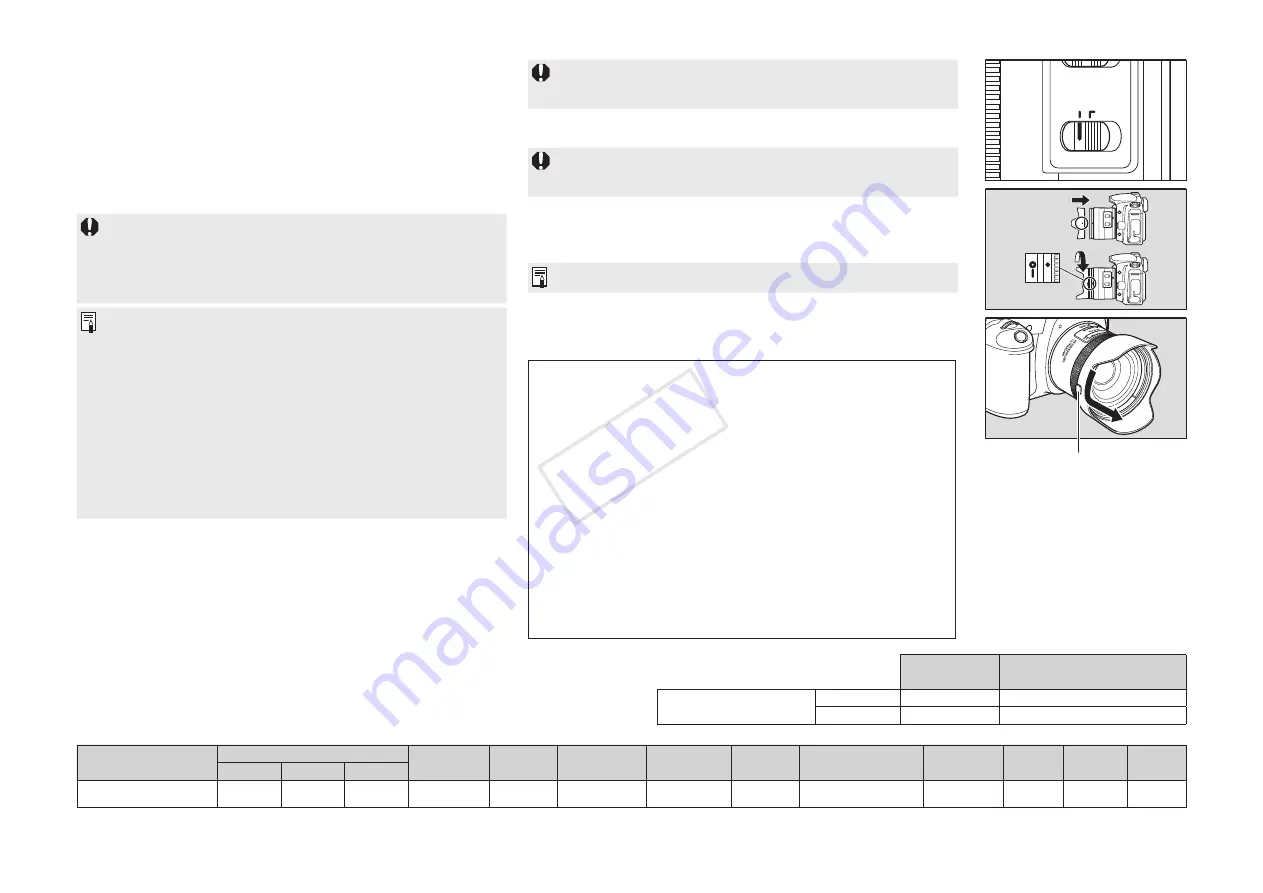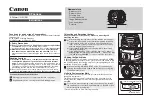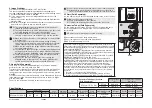
CT1-8586-000
1206SZ
© CANON INC. 2012
ON
STABILIZER
OFF
●
❺
●
❼
●
❻
Button
4. Image Stabilizer
You can use the Image Stabilizer in AF or MF mode.
This function provides optimal image stabilization depending on
shooting conditions (such as shooting still subjects and following shots).
1. Set the STABILIZER switch to ON
❺
.
●
If you are not going to use the image stabilizer function, set the
switch to OFF.
2. When you press the shutter button halfway, the Image Stabilizer will
start operating.
●
Make sure the image in the viewfinder is stable, then press the shutter
button the rest of the way down to take the picture.
●
The Image Stabilizer cannot compensate for a blurred shot
caused by a subject that moved.
●
The Image Stabilizer may not be fully effective if you shoot from
a violently shaking vehicle or other transportation.
●
The Image Stabilizer consumes more power than normal
shooting, so fewer shots can be taken if you use the function.
●
When shooting a still subject, it compensates for camera shake
in all directions.
●
It compensates for vertical camera shake during following
shots in a horizontal direction, and compensates for horizontal
camera shake during following shots in a vertical direction.
●
When you use a tripod, the Image Stabilizer should be turned
off to save battery power.
●
The stabilizer is equally effective for handheld photography and
photography with a monopod. The Image Stabilizer effect may
be reduced, however, depending on the shooting environment.
●
The Image Stabilizer also operates when the lens is used with
extension tube EF12 II or EF25 II.
●
If you set the camera’s Custom Function to change the
assigned button to operate the AF, the Image Stabilizer will
operate when you press the newly assigned AF button.
5. Hood (Sold Separately)
The EW-72 hood can keep unwanted light out of the lens, and also
protects the lens from rain, snow, and dust.
To attach the hood, align the hood’s attachment position mark with the
red dot on the front of the lens, then turn the hood in the direction of
the arrow until the lens’s red dot is aligned with the hood’s stop position
mark
❻
.
To remove the hood, hold down the button on the side and turn the hood
in the direction of the arrow until the position mark on the hood aligns
with the red dot
❼
.
The hood can be reverse-mounted on the lens for storage.
●
Part of the picture may be blocked if the hood is not attached properly.
●
When attaching or detaching the hood, grasp the base of the hood to
turn it. To prevent deformation, do not grasp the rim of the hood to turn it.
6. Filters (Sold Separately)
You can attach filters to the filter mounting thread on the front of the lens.
●
Only one filter may be attached.
●
Use a polarizing Canon filter (67mm).
●
To adjust the polarizing filter, first remove the lens hood.
7. Extension Tubes (Sold Separately)
You can attach extension tube EF12 II or EF25 II for magnified shots.
For shooting distance and magnification, see the extension tube
specifications.
MF mode is recommended for accurate focusing.
●
The extenders cannot be used with this lens.
●
The close-up lenses cannot be used with this lens.
●
CASE (Sold Separately) LP1116
This device complies with Part 15 of the FCC Rules. Operation is subject to the
following two conditions: (1) This device may not cause harmful interference, and (2)
this device must accept any interference received, including interference that may
cause undesired operation.
Do not make any changes or modifications to the equipment unless otherwise
specified in the instructions. If such changes or modifications should be made, you
could be required to stop operation of the equipment.
This equipment has been tested and found to comply with the limits for a class B
digital device, pursuant to part 15 of the FCC Rules.
These limits are designed to provide reasonable protection against harmful
interference in a residential installation. This equipment generates, uses and can
radiate radio frequency energy and, if not installed and used in accordance with
the instructions, may cause harmful interference to radio communications.
However, there is no guarantee that interference will not occur in a particular
installation. If this equipment does cause harmful interference to radio or television
reception, which can be determined by turning the equipment off and on, the user
is encouraged to try to correct the interference by one or more of the following
measures:
• Reorient or relocate the receiving antenna.
• Increase the separation between the equipment and receiver.
• Consult the dealer or an experienced radio/TV technician for help.
Specifications
* Sold Separately
Angle of view
Lens
construction
Minimum
aperture
Max.
magnification
Min. focusing
distance
Filter
diameter
Max. diameter and
length
Weight
Hood* Lens Cap Case*
Diagonal Vertical Horizontal
EF35mm f/2 IS USM
63°
38°
54°
8-10
22
0.24x
0.24m/0.79ft
67mm
77.9x62.6mm
(3.1”x2.5”)
335g/11.8oz EW-72
E-67ll
LP1116
Extension Tube Specifications
(Sold Separately)
Magnification
(X)
Focusing Distance Range
(mm) (inch)
EF35mm f/2 IS USM
EF12 II
0.60-0.36
168-197 (6.6-7.6)
EF25 II
1.04-0.79
158-160 (6.2-6.3)
COP
Y


